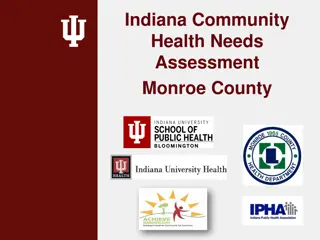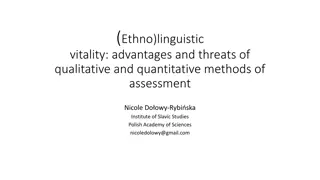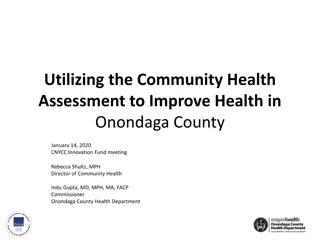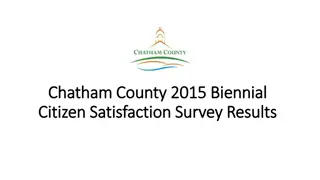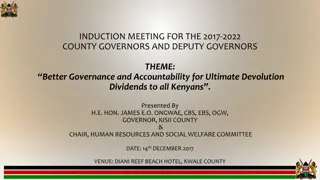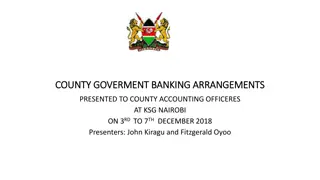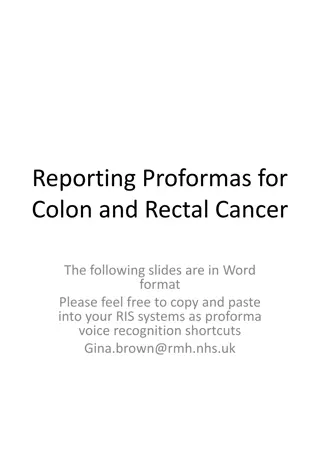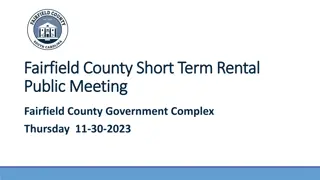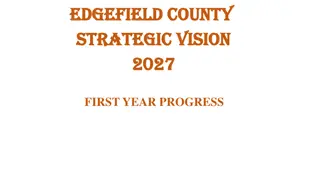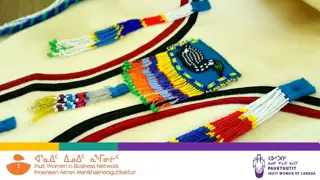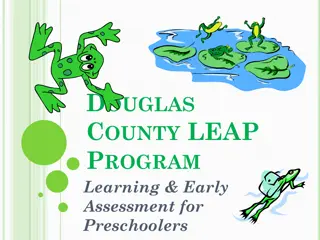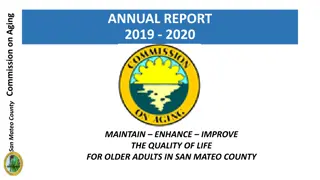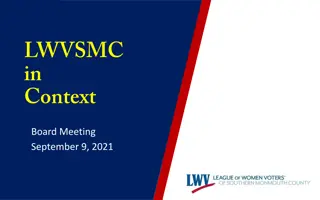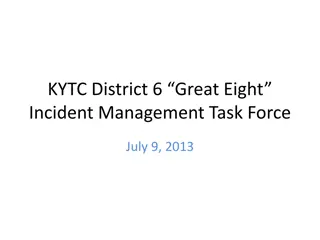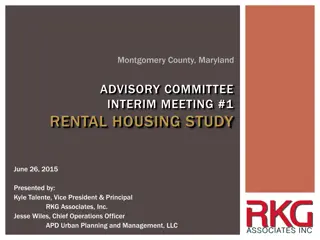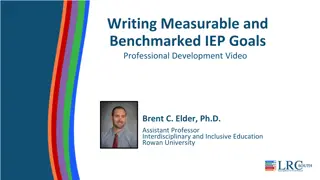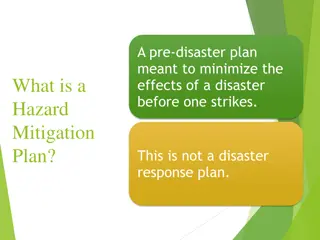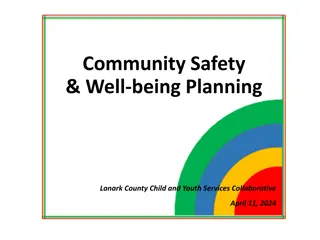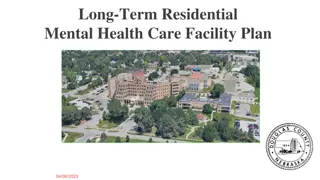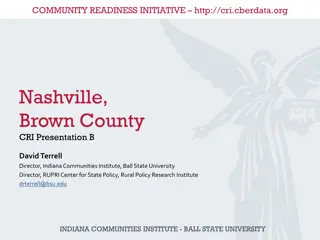Community Vitality Assessment in Wallowa County: 2009 Findings and Social Goals
Community Vitality Assessment conducted in Wallowa County in 2009 revealed areas of weakness and strength in environment, social, community capacity, and economy. The assessment indicated that Wallowa County is approximately 56% vital, with more than half of the indicators meeting or exceeding targets in three out of four areas. The findings highlighted the county's population demographics, quality of life attractants, and age distribution trends, emphasizing the importance of positive social, economic, and environmental outcomes for the community's well-being.
Download Presentation

Please find below an Image/Link to download the presentation.
The content on the website is provided AS IS for your information and personal use only. It may not be sold, licensed, or shared on other websites without obtaining consent from the author. Download presentation by click this link. If you encounter any issues during the download, it is possible that the publisher has removed the file from their server.
E N D
Presentation Transcript
2009 Wallowa County Vitality Assessment THE VITAL WALLOWA INDICATOR PROJECT
Community Vitality Assessment Methodology Community vitality: Capacity to work productively together and realize positive social, economic, and environmental outcomes 2. Developed 26 indicators of Wallowa County vitality: 2006 Vision & additional community input 3. Gathered data from: Federal, State, County, and City agencies Local organizations and businesses Wallowa County adult residents 4. Developed indicator targets 5. Made assessment of community vitality 1. The Vital Wallowa Indicator Project
Vital Wallowa Indicator Project Survey Survey Methodology: Hand-delivered February - May, 2009 by local residents Wallowa HS FCCLA, Joseph HS FBLA, Enterprise HS FBLA Adult volunteers Mail-back response rate: 63% Received completed questionnaires from 276 randomly selected Wallowa County adult (18+) residents Quotas established for area of the county to ensure a representative sample Margin of error: 5.8% for permanent adult resident estimates All published estimates have been weighted to represent the Wallowa County population of adult residents The Vital Wallowa Indicator Project
2009 Community Vitality Assessment Findings Areas of Weakness (< ) Areas of Strength ( ) Environment: 6/8 Social: 6/17 Community Capacity: 7/9 Economy: 4/7 According to the 2009 assessment, Wallowa County is roughly 56% vital, and in three areas out of four, more than half of the indicators met or exceeded targets. The Vital Wallowa Indicator Project
Social Goal 1.1 Wallowa County is rich in year-round residents, with a foundation of young people and families. Our quality of life attracts families, young people, and newcomers with similar values. The Vital Wallowa Indicator Project
Social: Goal 1.1 Population by Age, 2000 Oregon, Non-metropolitan Oregon, and Wallowa County Source: U.S. Census Bureau 35% OREGON Non-Metro OREGON Wallowa County 30% % of Population 25% 20% 15% 10% 5% 0% Age 0-17 Age 18-24 Age 25-44 Age 45-64 Age 65-79 Age 80+ Population by Age: The percentage of population age 25-44 in Wallowa County was lower than desired and the percentage of population age 45-64 in Wallowa County was higher than desired by residents 1. The Vital Wallowa Indicator Project
Social: Goal 1.1 Age-Specific Net Migration Rates, 1990 - 2000 Wallowa County, OR and Non-metropolitan Oregon Source: U.S. Census Bureau; National Center for Health Statistics; Voss, McNiven, Hammer, Johnson, and Fuguitt, 2004 1 0.8 Non-Metro OR Wallowa County 0.6 Rate Per Capita Net Migration 0.4 0.2 0 10-14 55-59 20-24 25-29 30-34 75+ 5-9 40-44 65-69 70-74 35-39 50-54 60-64 45-49 0-4 15-19 -0.2 -0.4 -0.6 -0.8 Migration by Age: The net migration rates of Wallowa County residents were higher than desired for some age groups. 2. The Vital Wallowa Indicator Project
Social Goal 1.2 We intentionally care for and nurture one another. The Vital Wallowa Indicator Project
Social: Goal 1.2 Health Care Satisfaction: Quality In 2009, the majority of residents (86%) were satisfied with the quality of care in the county Options In 2009, too many residents delayed care due to lack of options (16%) and felt there were too few provider options Access In 2009, the majority of residents were satisfied with the distance they traveled, did not travel far, and did not travel outside the county for care 3. % of Wallowa County adults satisfied with the number of health care providers in Wallowa County Source: 2009 Vital Wallowa Indicator Project Survey General Practitioners 100% Other Specialists Alternative Medicine Dentists, OB/GYNs, Optometrists, & Podiatrists Mental Health The Vital Wallowa Indicator Project
Social: Goal 1.2 Health Care Affordability: In 2006, a greater proportion of Wallowa County residents did not have health insurance than the proportion in Oregon. More than a quarter of residents delayed care in 2008-2009 because of cost. 4. The Vital Wallowa Indicator Project
Social Goal 1.3 We focus on our children, finding ways to connect youth with new opportunities in the community and to have a positive community experience. We support our population of young people and families. The Vital Wallowa Indicator Project
Social: Goal 1.3 Wallowa County Youth Participation in Activities, 2007 Source: Looking Toward the Future: Examining Aspirations among Rural Youth (Shamah, 2007) School sports 100% Sports outside of School Work for Pay Church School Activities Activities Outside of School 4-H Future Farmers of America % of Wallowa County Youth (grades 9-12) Youth Engagement: In 2007, Wallowa County was on target with respect to the proportion of youth who participate in activities outside of school hours. Youth tend to be concentrated in two activities, namely working for pay and school sports. Childcare Utilization: In 2009, preliminary results indicate that the most common form of care of youth under 14 was parental or unsupervised care. 5. 6. The Vital Wallowa Indicator Project
Social Goal 1.4 Educational and recreational opportunities are cultivated, and our culture of lifelong learning encourages sharing of our experiences The Vital Wallowa Indicator Project
Social: Goal 1.4 Participation in Educational Opportunities, Wallowa County Adults Source: 2009 Vital Wallowa Indicator Project 73% 80% % of Wallowa County adults 70% 57% 60% 51% 50% 40% 30% 20% 11% 10% 10% 0% Gave or received mentoring Took a class or attended a lecture anywhere Offered a class through any organization Took or offered a class in Wallowa County Participated in at least one type of educational opportunity Lifelong Learning: In 2008-2009, while the proportion of adult residents who participated in some form of lifelong learning was above target (70%), the proportion of adult residents who participated in lifelong learning opportunities within the county was below goal. The Vital Wallowa Indicator Project 7.
Social Goal 1.5 Our community is rich in year-round residents of young people and families who do not endure extreme economic disparity and who can carry the heritage of agriculture and ranching forward in the next generation. The Vital Wallowa Indicator Project
Social: Goal 1.5 Workforce Housing: In 2000, the majority (65%) of Wallowa County renters who earned less than the county median income spent more than 30% of their income on housing. 9. The Vital Wallowa Indicator Project
Social: Goal 1.5 10. Farm & Ranch Ownership: In 2009, 56% of private farm, ranch, or forest landowners lived in Wallowa County, while 44% lived elsewhere. The Vital Wallowa Indicator Project
Social: Goal 1.5 11. Seasonal Homeownership % of housing units vacant for seasonal use Wallowa County 13% ZIP code 97828 11% ZIP code 97842 31% ZIP code 97846 16% ZIP code 97857 8% ZIP code 97885 East County: Joseph, the east side of Wallowa Lake, and Imnaha West County: Wallowa, Lostine, and Troy 4% 15% 11% Central County: Enterprise and the west side of Wallowa Lake 12% The Vital Wallowa Indicator Project
Economy Goal 2.1 Wallowa County provides stable and living wage jobs The Vital Wallowa Indicator Project
Economy: Goal 2.1 Ratio of Average Earnings to Cost of Living (single wage- earner) 1.01 2007 Cost of living (Basic Family Budget) for Wallowa County families of various compositions: 2007 Average Wallowa County Earnings: 1 parent with 1 child $25,236 1 parent with 3 children $41,556 .61 $25,523 2 parents with 1 child $34,368 .74 2 parents with 3 children $47,004 .54 12. Living Wage Jobs: In 2007, it was only possible for single- wage earner families of one parent and one child to support themselves with the average job in Wallowa County. The Vital Wallowa Indicator Project
Economy Goal 2.2 We capture the value of local businesses and high quality agriculture through new products and niche markets serving residents, visitors, and customers outside the area. The Vital Wallowa Indicator Project
Economy: Goal 2.2 2007 Values of Exports from & Imports into Wallowa County Source: Minnesota IMPLAN Group, Inc., Sorte (2009) $250 $250 Millions of Dollars $200 Value of Exports Value of Imports $165 $150 $100 $50 $0 14. Balance of Trade: In 2007, the value of exports was 66% the value of imports. The Vital Wallowa Indicator Project
Economy Goal 2.3 In addition to carrying agriculture and ranching forward into the next generation, Wallowa County cultivates a balance of compatible locally-owned small businesses, which add to our diverse and innovative economy. The Vital Wallowa Indicator Project
Economy: Goal 2.3 Businesses by Employee Size, Wallowa County, OR 1st Quarter 2009 Source: OR Employment Department 15. Small & Large Business Health: Between 2008 and 2009, the growth rate of small businesses was +6% and for large businesses was -16%. Businesses with 0 employees 32, 8% 68, 18% 86, 23% Businesses with 1-4 employees 16. Employers by Size: In 2009, Wallowa County was below target for the number of firms in each employee size class, but on target with respect to the percentage of businesses in the county of each size class. Businesses with 5-9 employees 191, 51% Businesses with 10 or more employees The Vital Wallowa Indicator Project
Economy: Goal 2.3 Percentage of Jobs by Industry, Wallowa County, OR 2007 Source: U.S. Bureau of Economic Analysis 19% Ag. proprietors & laborers, Forestry, fishing, mining, etc. Manufacturing 5% Retail trade 47% Professional, scientific, management, admin, and waste mgmt services Arts, entertainment, recreation, accommodation, and food services Other industries 12% 7% 10% 17. Employment in Industries Targeted by Economic Development Strategy: In 2007, the five targeted industries were responsible for about 53% of all jobs in the county. The Vital Wallowa Indicator Project
Environment Goal 3.1 High-speed telecommunication and transportation infrastructure helps us export our products and services as well as attracts families and young people More data needed The Vital Wallowa Indicator Project
Environment Goal 3.2 Wallowa County is home to wide-open spaces, intact ranchlands, and a healthy environment The Vital Wallowa Indicator Project
Environment: Goal 3.2 Wallowa County Land Use, 2009 Sources: USDA Census of Agriculture, US Forest Service 507 Public Wilderness Acres Residential, Commercial, Industrial, Private reserves, and Other Private Woodland Acres 548,978 423,748 Private Cropland Acres Private Permanent Pasture or rangeland Acres Forest Service Permitee Acres 579,648 354,568 Wallowa-Whitman Natl. Forest Timber Sale Acres 44,775 60,793 19. Working Landscapes: In 2009, 50% of Wallowa County land was actively managed for grazing, timber, and farming. The Vital Wallowa Indicator Project
Environment: Goal 3.2 Percentage of Private Wallowa County Landowners who allow the public access to their land for hunting, fishing, or other recreation, 2009 Source: 2009 Vital Wallowa Indicator Project Survey 40% 34% 30% 30% Hunting Fishing Other Recreation 20% 13% 10% 0% 20. Land Access for Hunting, Fishing, & Recreation: In 2009, adequate amounts of public land (423,000 acres) and private landowners allow public access for these activities. The Vital Wallowa Indicator Project
Environment: Goal 3.2 Scotch Thistle Image courtesy of Eric Coombs, Oregon Dept. of Agriculture 21. Water Quality: In 2004-2006, 522 miles of stream reaches in Wallowa County were water quality limited. 22. Noxious Weeds: In 2009, the number of acres treated met current year goals, the number of acres formally inventoried met annual goal levels, and only the number of acres under active restoration was slightly below target. The Vital Wallowa Indicator Project
Community Capacity Goal 4.1 Our small towns, local businesses, and active volunteers collaborate to create a shared future for the county The Vital Wallowa Indicator Project
Society & Culture: Goal 4.2 Civic Participation of Wallowa County Adults Source: 2009 Vital Wallowa Indicator Project Survey Attended public meetings 100% Helped raise money Participated on boards Donated money, services, materials Volunteered time % of Wallowa County resident adults Applied or ran for public office Civic Participation: Between 2008 and 2009, 79% of Wallowa County adults participated in 2 or more civic activities in the county. Some groups were not equitably represented, however. County Government Revenues: In 2008-2009, 35% of revenues came from fees, taxes, and grants and spending was at about $2,000 per capita The Vital Wallowa Indicator Project 23. 24.
Community Capacity Goal 4.2 We intentionally nurture and connect year- round residents, including young people and families, through community events and community spaces, in order to foster a cohesive and collaborative community environment The Vital Wallowa Indicator Project
Society & Culture: Goal 4.2 The Places Wallowa County Residents Often or Always Got Together with Friends or Neighbors in 2009 Source: 2009 Vital Wallowa Indicator Project 0% 10% 20% 30% 40% 50% 60% 70% Private Residence 64% Church Caf 29% 22% Restaurant 20% Other public place 13% 12% Pub Bar Park 6% 4% Grange 2% 25. Community Gatherings & Spaces: In 2009, there were abundant spaces in the community to meet, though many residents preferred to get together with each other at private residences. The Vital Wallowa Indicator Project
Society & Culture: Goal 4.2 Community Capacity & Trust in Wallowa County, 2009 (% of Wallowa County adults who agree that...) Source: 2009 Vital Wallowa Indicator Project Survey Local government has the ability to deal effectively with important problems 55% If this community were faced with a local issue, people here could be counted on 84% People in this community generally trust one another and get along 82% People around here are willing to help their neighbors 91% 0% 20% 40% 60% 80% 100% 26. Community Capacity: In 2009, Wallowa County residents felt that they worked together well as a community. The Vital Wallowa Indicator Project
2009 Community Vitality Assessment Findings Areas of Weakness (< ) Areas of Strength ( ) Environment: 6/8 Social: 6/17 Community Capacity: 7/9 Economy: 4/7 According to the 2009 assessment, Wallowa County is roughly 56% vital, and in three areas out of four, more than half of the indicators met or exceeded targets. The Vital Wallowa Indicator Project
Discussion Is this assessment consistent with your perceptions of the strengths and weaknesses of the county? What has helped the county realize its positive outcomes? What strategies could be adopted to start improving in particular areas?
For more information Indicator Report Summary Full Indicator Report contact Nils Christoffersen: nils@wallowaresources.org or Lena Etuk: lena.etuk@oregonstate.edu Oregon Rural Communities Explorer: www.oregonexplorer.info/rural In the Community Vitality section Thank You! The Vital Wallowa Indicator Project


